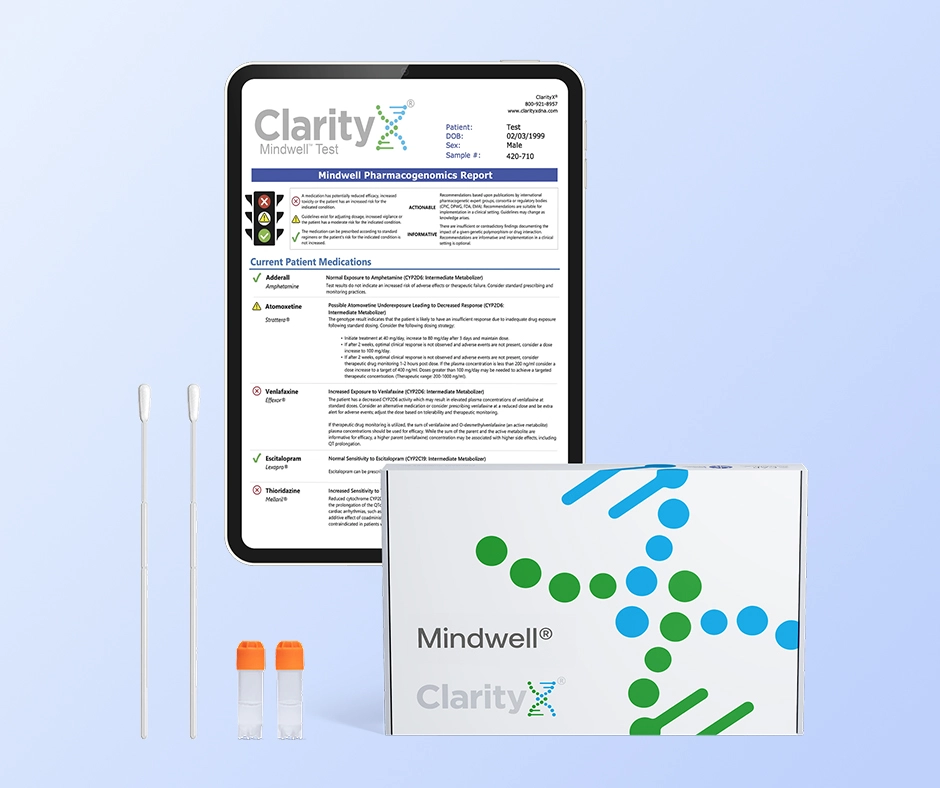Discover the differences between fluvoxamine and Lexapro and how to pick the best antidepressants for your health needs.
Fluvoxamine® vs. Lexapro®
Over 17 million Americans struggle with major depression, a condition characterized by consistent feelings of sadness. Over time, these feelings can escalate and cause poor physical and mental health. To help lower the effects of depression, many healthcare providers prescribe antidepressant drugs, a class of medication that alters chemicals in the brain.
When it comes to antidepressants, there are plenty of options to choose from — unfortunately, this can make it difficult to find the best antidepressants for your needs. In this guide, we’ll evaluate the differences between two popular major depression treatments: fluvoxamine and Lexapro. Here’s a closer look at what they are, their potential side effects, and how a DNA test can help you and your healthcare provider choose the right treatment.
Fluvoxamine vs. Lexapro: What Are They?
Fluvoxamine is a generic drug name that includes brands like Luvox. In addition to treating major depression, it’s often used to lower symptoms of obsessive-compulsive disorder (OCD) and social anxiety disorder. Lexapro, on the other hand, is a branded version of a generic drug (escitalopram). Healthcare providers may prescribe it to treat depression or generalized anxiety disorder.
Both of these antidepressants are selective serotonin reuptake inhibitors (SSRIs), which work by increasing the amount of serotonin in your brain. Serotonin is a chemical messenger that transports signals between neurons and affects the following:
- Mood
- Emotions
- Digestion
- Sleep
By blocking neurons from reabsorbing serotonin, SSRIs can increase the levels of serotonin that remain in the brain and help improve mood and boost happiness. Although they’re similar to antidepressants in many ways, both drugs differ in terms of side effects and dosages.
Fluvoxamine vs. Lexapro: Common Side Effects
Whenever you introduce a new medication into your system, there’s a risk of adverse effects. As part of our Lexapro vs. fluvoxamine guide, we’ll go through the unique side effects common for both these drugs, as well as the side effects they share.
Side Effects Common With Fluvoxamine
People who take fluvoxamine may experience the following:
- Diarrhea
- Skin rashes
- Fatigue
- Sore throat
- Muscle pain
In some cases, fluvoxamine can trigger a loss of appetite (leading to weight loss).
Side Effects Common With Lexapro
Here are a few side effects that may occur when taking Lexapro:
- Constipation
- Heartburn
- Ear ringing
- Fluctuations in weight
In comparison to fluvoxamine, Lexapro tends to have fewer side effects and can interact better with other medications. Of course, this varies from person to person.
Shared Side Effects
Drug information shows that both fluvoxamine and Lexapro users may undergo the following:
- Nausea and dizziness
- Dry mouth
- Difficulty sleeping
- Sexual side effects
Usually, these effects go away as your body gets used to the drug. However, if they persist (or if you experience very severe side effects), you should consult your healthcare provider about changing your dosage or medication.
Fluvoxamine vs. Lexapro: Dosage
Fluvoxamine Dosage
While each case is unique, many patients receive similar dosages — below is a general outline.
Fluvoxamine, or Luvox, is available in two forms:
- Tablet
- Extended-release tablet
For new users taking the regular tablet, most healthcare providers start off with a 50 mg daily dosage. Conversely, the extended-release tablet starts at 100 mg per day (with a maximum of 300 mg daily). It can take anywhere from two to eight hours for fluvoxamine to absorb in the body, and up to four weeks to begin working.
Lexapro Dosage
Lexapro (escitalopram) is available in two forms:
- Tablet
- Liquid
The most commonly used method is the tablet or pill. When prescribing Lexapro to a new user, healthcare providers generally start at 10 mg daily (this may increase up to 20 mg daily). Lexapro takes about three to four hours to absorb, and up to six weeks to start working.
Fluvoxamine Or Lexapro: Which One Should I Take?
Fluvoxamine and Lexapro share many qualities — they’re both SSRIs, they have the potential to cause severe side effects and they can be used to treat depression and anxiety disorders. Due to these similarities, it can be difficult to decide which one is right for you.
To make this choice, many healthcare providers play a game of trial and error. This involves prescribing one drug, viewing the results, then either adjusting the dosage or switching to another medication. However, you can skip this time-consuming, burdensome process with pharmacogenetic testing, or DNA testing.
ClarityX: DNA Testing For Medication
Our DNA contains valuable information about how we respond to certain medications. At ClarityX, we examine DNA, discover this information and give patients detailed reports on how they may react to new drugs. More specifically, we look for variations with the cytochrome 450 enzymes (which metabolize over 70% of drugs). We offer two test options:
- Mindwell test: This test focuses on treatments for mental wellness conditions (such as depression, anxiety, ADHD, and OCD).
- Max Rx test: This test covers 31 therapeutic areas and tests your response to over 265 medications.
Both the Mindwell and Max Rx tests can determine how you’ll react to Lexapro and fluvoxamine, which helps both you and your healthcare provider make better treatment choices. Click here to learn more.





